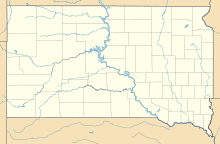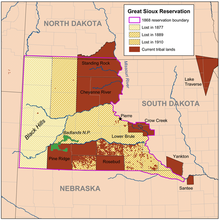Fort Meade, South Dakota
Coordinates: 44 ° 25 ′ 0 ″ N , 103 ° 31 ′ 0 ″ W.
Fort Meade is a former stronghold of the US Army east of Sturgis in Meade County , South Dakota . The site is now used by the South Dakota National Guard as a training ground and training facility. A United States Department of Veterans Affairs hospital is also located on the premises. Fort Meade was established in 1878 as a US cavalry base to protect the northern Black Hills after the area was separated from the Great Sioux Reservation in 1877 . Fort Meade is often confused with the fort of the same name in the US state of Maryland , the headquarters of the NSA . Fort Meade played an important role in the Indian Wars . It is closely tied to the history of the Deadwood , South Dakota gold rush settlement, which it was originally built to protect. The fort was named after the American Civil War general George Gordon Meade .
history
The Great Sioux Reservation was created through the Treaty of Fort Laramie in 1868 . The treaty laid the area of the entire present-day US state of South Dakota west of the Missouri, including the Black Hills (from the northern border in Nebraska to the 46th parallel and from Missouri in the east to the 104th meridian in the west) as Indian land unrestricted and unmolested use and settlement by the Great Sioux Nation . The area thus also included the location of Fort Meade. In 1874, Lieutenant Colonel George Armstrong Custer was assigned an expedition to the Black Hills area. Gold was found in French Creek , which led to an onslaught of thousands of prospectors . The US Army tried to keep the prospectors out of the Black Hills, which was unsuccessful due to insufficient personnel. Individual Sioux troops hunted down invaders. Eventually the US government began negotiating the purchase of the reservation with the Oglala-Lakota . However, the reservation Indians under Red Cloud declined to sell. Certain groups under Sitting Bull , Crazy Horse and Gall had never recognized the contract of 1868 anyway and stayed outside the Sioux reservation in the non-ceded hunting areas. In December 1875 the government decided to drive the Indians out of the Black Hills. She gave the Indians an ultimatum to “return” to the reservation in the middle of winter and thus to clear the Black Hills for the whites. Aside from the fact that many Sioux and Northern Cheyenne did not come from reservations to return to, they would have been unable to meet the ultimatum in the dead of winter. In the spring of 1876 fighting broke out, culminating in the Battle of Little Bighorn on June 25, 1876, in which parts of the 7th US Cavalry Regiment were destroyed and Custer was killed. After the battle, other army units were relocated to the disputed area. In this context, a temporary military camp was set up north of Bear Butte, a sacred mountain of the Cheyenne Indians, in August 1876 to protect the settlers and prospectors from rebellious Indians. On August 31, 1878, the temporary encampment became a permanent military base south of Bear Butte, after the US government illegally annexed the area in 1877 . At the direction of the Secretary of Defense, the fort was named after General George Gordon Meade. At first the fort was used as a base for parts of the 1st US Infantry Regiment. Parts of the 7th US Cavalry Regiment were also stationed at the fort. Units stationed here later were part of the 25th and 3rd US Infantry Regiments, as well as the 4th, 8th and 10th US Cavalry Regiments. Four infantry and six cavalry companies could be stationed at the same time in the fort .
The US Army abandoned the fort in 1944. Since then, the site has been used as a hospital for the United States Department of Veterans Affairs.
Web links
- Fort Meade Recreation Area (English)
- Letter Descriptions of Dakota Territory Forts (English)
- Fort Meade (English)
- Fort Meade National Cemetery (English)
- Fort Meade Museum (English)
- Fort Meade: From Frontier Post to High-Tech Military and Modern Medicine (English)
- Veterans Affairs Black Hills Health Care System - Fort Meade Campus (English)
literature
- Fort Meade and the Black Hills by Robert Lee, University of Nebraska Press 1991
Individual evidence
- ↑ Fort Meade From Frontier Post to High-Tech Military and Modern Medicine Ft. Meade has endured for over a century and progressed to meet the current needs of the US military as a Veteran's Hospital and training center for the South Dakota National Guard.
- ^ Brief Descriptions of Dakota Territory Forts and is currently the home of the regional National Guard Officer Training Academy.
- ↑ Contract text in English
- ↑ fortmeademuseum.org ( Memento of the original from August 17, 2016 in the Internet Archive ) Info: The archive link was inserted automatically and has not yet been checked. Please check the original and archive link according to the instructions and then remove this notice. It outlived all other frontier posts of the Upper Missouri West, surviving as a military installation until 1944 when in became a Veterans Administration Hospital as it remains today.

